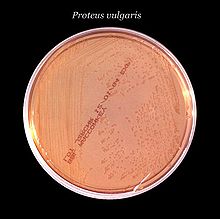- MacConkey agar
-
MacConkey agar is a culture medium designed to grow Gram-negative bacteria and stain them for lactose fermentation.[1]
Contents
Contents
It contains bile salts (to inhibit most Gram-positive bacteria, except Enterococcus and some species of Staphylococcus i.e. Staphylococcus aureus), crystal violet dye (which also inhibits certain Gram-positive bacteria), neutral red dye (which stains microbes fermenting lactose), lactose and peptone.
Composition: [2]
- Peptone - 17 g
- Proteose peptone - 3 g
- Lactose - 10 g
- Bile salts - 1.5 g
- Sodium chloride - 5 g
- Neutral red - 0.03 g
- Agar - 13.5 g
- Water - add to make 1 litre; adjust pH to 7.1 +/- 0.2
There are many variations of MacConkey agar depending on the need. If the spreading or swarming of Proteus species is NOT required, sodium chloride is omitted. Crystal violet at a concentration of 0.0001% (0.001 g per litre) is included when we need to check if Gram-positive bacteria are inhibited.
History
The medium was developed by Alfred Theodore MacConkey while working as a bacteriologist for the Royal Commission on Sewage Disposal.
Uses
Acting as a visual pH indicator, the agar distinguishes those Gram-negative bacteria that can ferment the sugar lactose (Lac+) from those that cannot (Lac-).
This medium is also known as an "indicator medium" and a "low selective medium". Absence of electrolytes serves to inhibit swarming by Proteus species.
Lac+
By utilizing the lactose available in the medium, Lac+ bacteria such as Escherichia coli, Enterobacter and Klebsiella will produce acid, which lowers the pH of the agar below 6.8 and results in the appearance of red/pink colonies. The bile salts precipitate in the immediate neighborhood of the colony, causing the medium surrounding the colony to become hazy.[3][4]
Lac-
Non-Lactose fermenting bacteria such as Salmonella, Proteus species, Pseudomonas aeruginosa and Shigella cannot utilize lactose, and will use peptone instead, with the exception of Shigella sonnei, which is a late lactose fermentor[5]. This forms ammonia, which raises the pH of the agar, and leads to the formation of white/colorless colonies formed in the plate. But they can also look golden to brown with dark centers. They are circular colonies and arranged randomly.
Slow
Some organisms ferment lactose slowly or weakly, and are sometimes put in their own category. These include Serratia[6] and Citrobacter.[7]
Variant
A variant, Sorbitol-MacConkey agar, (with the addition of additional selective agents) can assist in the isolation and differentiation of enteropathogenic E. coli serotypes such as E. coli O157:H7, by the presence of white circular colonies that are non-sorbitol fermenting.
See also
References
- ^ "tmc.edu". http://medic.med.uth.tmc.edu/path/macconk.htm.
- ^ http://www.microbelibrary.org/index.php/component/resource/laboratory-test/2855-macconkey-agar-plates-protocols
- ^ MacConkey AT (1905). "Lactose-Fermenting Bacteria in Faeces.". J Hyg (Lond) 5 (3): 333–79. PMID 20474229.
- ^ MacConkey AT (1908). "Bile Salt Media and their advantages in some Bacteriological Examinations.". J Hyg (Lond) 8 (3): 322–34. PMID 20474363.
- ^ http://microbewiki.kenyon.edu/index.php/Shigella_sonnei
- ^ Luis M. De LA Maza; Pezzlo, Marie T.; Janet T. Shigei; Peterson, Ellena M. (2004). Color Atlas of Medical Bacteriology. Washington, D.C: ASM Press. pp. 103. ISBN 1-55581-206-6.
- ^ "Medmicro Chapter 26". Archived from the original on 2008-07-06. http://web.archive.org/web/20080706194735/http://gsbs.utmb.edu/microbook/ch026.htm. Retrieved 2008-12-11.
Growth media / agar plates Selective media AlphaproteobacteriaBrucella abortus (Brucella agar)BetaproteobacteriaDifferential media Lactose fermenting gram negative (MacConkey agar/Sorbitol-MacConkey agar, Eosin methylene blue) · Hektoen enteric agar · sulfur (Bismuth sulfite agar)Fungal media Nonselective media Other/ungrouped media Cysteine lactose electrolyte deficient agar · Cystine tryptic agar · Endo agar · LIA slant · Müller-Hinton agar/PNP agar · R2a agar · Simmons' citrate agar · Trypticase soy agar · TSI agarCategories:- Microbiological media
- Growth media
Wikimedia Foundation. 2010.



